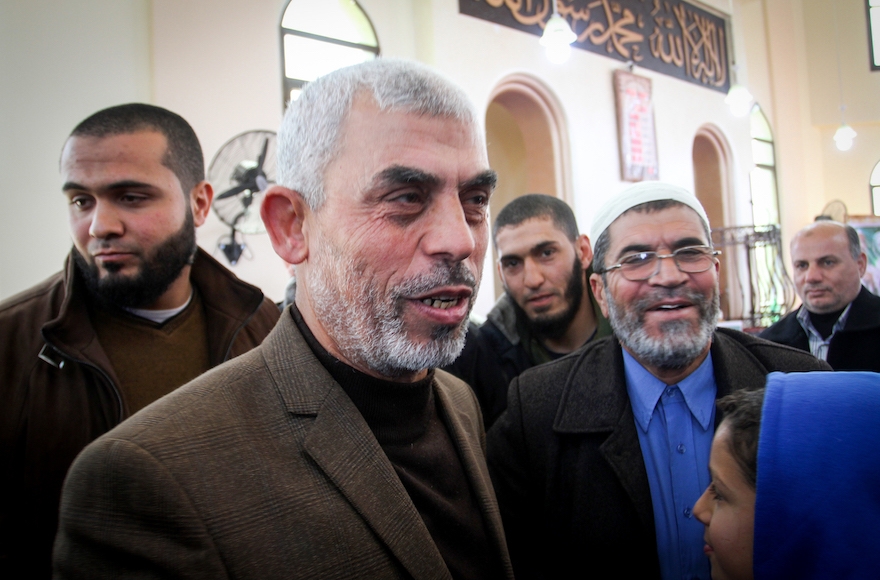Israel reportedly kills Hamas chief Yahya Sinwar
Sinwar’s removal could accelerate the hostages’ release and an end to the war in Gaza even as it has intensified in Lebanon and the threat of an Iran war still looms

Yahya Sinwar at the opening of a new mosque in Rafah, in the southern Gaza Strip, Feb. 24, 2017. (Abed Rahim Khatib/ Flash90)
(JTA) — Yahya Sinwar, the architect of the deadliest attack on Israel in its history, was killed in a shootout with Israeli forces, Israeli officials reportedly have said.
Kan, Israel’s government-run radio network, quoted senior official sources as saying that DNA testing confirmed that the Hamas chief was one of three terrorists killed in a shootout Thursday with Israeli forces in Rafah, the city on the Gaza-Egypt border.
Israeli officials would not confirm the report to the Jewish Telegraphic Agency. Then army had earlier said that it was seeking to confirm whether a slain man resembling Sinwar was indeed the terrorist leader.
U.S. officials saw Sinwar as the principal obstacle to the release of hostages and a ceasefire. His killing could accelerate the hostages’ release and an end to the war in Gaza even as it has intensified in Lebanon and the threat of an Iran war still looms. A major success for Israel could also tamp down tensions between the Netanyahu and Biden governments.
Photos of a man resembling Sinwar with part of his head blown off circulated on social media.
There were official hints that Sinwar was killed. Yoav Gallant, the Israeli defense minister, posted on X a trio of portraits: A blank one with a red X, flanked by photos of Hezbollah chief Hassan Nasrallah and Mohammed Deif, Sinwar’s deputy, with red Xs over their faces. Israel in recent months assassinated Deif and Nasrallah.
“‘You will pursue your enemies and they will fall before you by the sword.’ – Leviticus 26 Our enemies cannot hide,” Gallant said. “We will pursue and eliminate them.”
The army released a photo of the heads of the army and the Shin Bet, the internal security service, in an aircraft, consulting, with no further explanation. Such photos have previously hinted at a major operation.
Sinwar plotted the Hamas invasion on Oct. 7, 2023 that massacred 1,200 people and abducted more than 250, launching a war that has roiled the Middle East and Israel’s relations with the United States and much of the world.
Documents recovered by the Israeli army and delivered in recent days to major Western news outlets revealed that Sinwar hoped to draw Iran and Hezbollah into the war. Both entities intensified their engagement with Israel, but resisted full involvement until recent weeks. Sinwar still hoped for the conflagration to metastasize and resisted deals for a ceasefire that would effectively require his surrender.
Hezbollah, a Lebanon-based terrorist group, intensified its rocket attacks on Israel on Oct. 8, 2023, leading to the evacuation of tens of thousands of Israeli and Lebanese civilians on both sides of the border. But the conflict in the north did not intensify until the summer, and culminated in the assassination of Nasrallah and much of the Hezbollah leadership last month.
Jonathan Schanzer, the vice president of the Foundation for the Defense of Democracies, said Sinwar’s killing is a game changer that could accelerate the release of some 100 hostages still held in Gaza. He noted that much of there Hamas leadership has been eliminated, with only Khaled Meshaal, who is based in Qatar, the only name with international resonance, left alive. Israel assassinated Ismail Haniyeh, Hamas’ political chief, in Iran over the summer.
“If he’s gone it leaves a huge vacuum ,” he said. “There is considerable leverage for the U.S. to force the release of hostages, to force surrender, to force the extradition of Meshaal to Israel, the U.S. or a third country.”
Sinwar and his two companions were killed in a shootout with conscripted soldiers from a non-elite unit who were on patrol and who did not know whom they were confronting, Kan reported. Hostages were not in the vicinity. Yedioth Achronoth reported that Israeli prime Minister Benjamin Netanyahu had informed the families that no hostages were known to be affected by the killing.
Gershon Baskin, who in 2011 helped negotiate the exchange of Sinwar among more than a thousand Palestinian prisoners in exchange for Israeli soldier Gilad Shalit, told Kan that any hostage deal would take at least a few days. Hamas officials, whom Baskin still is in touch with — although he said he was not able to reach any on Thursday — have previously told him that it would take at least 3-4 days of a total ceasefire to track down the hostages held in various places around the Gaza Strip.
Israel’s retaliatory measures in Gaza and Lebanon have taken the lives of tens of thousands of people, although there is no breakdown of how many were civilians and how many were combatants. Gaza is believed to be on the verge of or well into a famine, and most of its population of more than 2 million people have been displaced.
The carnage has led to international opprobrium, which Israel says is underserved, including investigation launched against Israel and its top officials in international courts.
Schanzer said the killing would substantively shift relations between the Israeli and American governments. He noted that earlier this week the Biden administration had warned Israel that it needed to accelerate the entry into Gaza of humanitarian assistance or face the possibility of restrictions on weapons transfers in 30 days.
“Yesterday we were watching a spat evolve between the White House and Israel about Israel’s freedom of action in Gaza over the next 30 days,” he said. “That may be a moot point right now, because we already know that 23 out of 24 Hamas have been destroyed. The top commanders are no longer alive. The infrastructure above ground has been destroyed. The underground infrastructure has been mapped almost entirely, and somewhere between 10 and 15% of that has been destroyed.”
He predicted low-level counterinsurgency operations for now and stasis in the broader war until after the U.S. presidential elections next month, when regional powers will have a better idea of how to go forward in ending the war and rebuilding the Gaza Strip and Lebanon.
A message from our Publisher & CEO Rachel Fishman Feddersen

I hope you appreciated this article. Before you go, I’d like to ask you to please support the Forward’s award-winning, nonprofit journalism so that we can be prepared for whatever news 2025 brings.
At a time when other newsrooms are closing or cutting back, the Forward has removed its paywall and invested additional resources to report on the ground from Israel and around the U.S. on the impact of the war, rising antisemitism and polarized discourse.
Readers like you make it all possible. Support our work by becoming a Forward Member and connect with our journalism and your community.
— Rachel Fishman Feddersen, Publisher and CEO

























